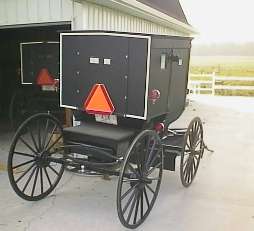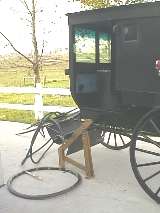Lead us not into Temptation

One of thirty Amish buggies Orley Yoder will build this year.
 Monday, October 5, 1998, Goshen, Indiana -
The sound of an Amish, one-horse buggy passing by at a canter is actually quite beautiful. The simple, clip-clop-clip-clop of hooves on pavement, moving from one edge of your perspective to the other, quietens the atmosphere. There is no engine noise, no horn or blaring radio, just the precise rhythm of an animal working for its keep. It is the sound of simplicity and modesty - it is the sound of the Amish lifestyle.
Monday, October 5, 1998, Goshen, Indiana -
The sound of an Amish, one-horse buggy passing by at a canter is actually quite beautiful. The simple, clip-clop-clip-clop of hooves on pavement, moving from one edge of your perspective to the other, quietens the atmosphere. There is no engine noise, no horn or blaring radio, just the precise rhythm of an animal working for its keep. It is the sound of simplicity and modesty - it is the sound of the Amish lifestyle.
Orley W. Yoder makes Amish buggies, and he makes them so well that he has a year and a half long backlog of orders. Before this, he made clocks, and he could probably do very well making souvenirs for tourists, but "I'd just rather do something for our own people," he says.
Against the nearly gaudy backdrop of our modern world, the Amish can be a curious sight. The contrast makes for easy jokes (several poor movies have been made) and they have become a major tourist attraction in Pennsylvania, Ohio and Indiana. I have only known a single Amish person for about two hours, so forgive my generalizations, but they seem like very nice people.
It is almost a sport to try to find contradictions in the Amish lifestyle. I confess that I got an impulse to snicker when I looked inside an Amish buggy, with its starkly simple design, modest coloring and severe lack of accessories, and I saw a nifty, folding, plastic cup holder.
But this reaction only shows confusion with the faith. Let's start at the beginning.
A Brief History of Anabaptism*
January 21, 1525, a group of people who believed that the state had gotten too involved in the church, baptized several adults, an act which was forbidden by Protestants and Catholics, who believed that only children should be baptized. The "Anabaptists" as they are called, were violently persecuted. The next two centuries brought development of three distinct Anabaptist groups, which still exist today.
Jacob Hutter organized a group in Czechoslovakia in 1528, which became known as Hutterites. This group practiced communal living, and still does, in Canada, England, the United States and Japan.
Eight Years later, the Dutch Priest, Menno Simons, joined the faith and soon started his own group called the Mennonites. This is presently the largest of the three Anabaptist groups, with members in 57 countries who drive cars and who dress and work more like people in their surrounding communities.
157 years later, in 1693, Jacob Ammann, upset with the lack of spiritual discipline in the Mennonites, started his own group in Switzerland, called the Amish. This group, now living mostly in North America, shuns modern conveniences. Amish men are required to wear beards, whereas Hutterite and Mennonite men are not.
|
The rules Amish live under vary from church to church (called "districts") so it is hard to generalize rules about the way they live. They do have many common philosophies though. You may see an Amish person in a car, but it won't be his or her car. You may even see one on TV or in a photograph, but it won't be their doing and it won't be their pleasure.
"We try and base all our rules on the scripture, he says. "If it doesn't match up with the scripture, then there's no foundation there."
The scripture doesn't say anything about manufactured homes, and the Yoder family lives in one, with aluminum siding and electrical wiring. The siding is practical and the wiring came with the house. Amish build homes without electrical wiring, Yoder tells me, even though this pretty much limits the sale of these houses to only Amish.
The electricity example offers insight to the Amish lifestyle. "We want to keep away from the temptation," Yoder says. Simply put, if you have electricity in your house, then you just have a world of opportunity for complicating your life.
Though they try to lead a simple life, Amish will use whatever tools that are practical to get the job done. Yoder's buggy shop has a good assortment of tools, including air-powered drills and saws. The air is provided by a gas compressor, a table saw is powered by a Honda gas engine and Yoder may buy a gas-powered generator so he can charge buggy batteries. It sounds complicated, having to maintain all these engines, but it is still simpler than having electricity, they believe.
Amish people will use computers, Yoder says, if their job requires it, but they won't have one in their home. Many Amish hold jobs outside their community. Hang around for shift change at the Jayco manufacturing plant in Middlebury and you will see several white-bearded bicyclists among the workers coming and going.
The Yoders have three girls and one boy - their oldest child is ten. Orley Yoder's parents had five children. These are small numbers, where historically, Anabaptist families would have upwards of a dozen children. Large families contribute to farm chores as well as bolster the flock. But today, many Amish are not farmers (the Yoders have a vegetable garden). Making and selling products for each other and to tourists is a booming business for the men and women in black.
Yoder likes the trend of public schools requiring student uniforms. "Nobody's better than the other," he says. "They're all the same." But he doesn't like at least one style of teaching at the school his children attend. "It just disturbs me when my daughter comes home and can't do math without using a calculator," he says.
The average Amish district has thirty families in it, and there are eighty districts in northern Indiana, Yoder says. His district has forty families and if it gets any larger, it will be split into two districts.
Every other week, Amish people attend districts other than their own, Yoder tells me. The ministers also circulate among the districts. This helps circulate ideas, add variety to sermons and strengthen the community.
It isn't that the Amish don't like cars, they just don't like the expense, complication and danger of them. When an Amish needs to travel far away, they will hire a person to drive them. There is a network of drivers (mostly elderly) in the area.
 This buggy was hit by a car, an increasing
This buggy was hit by a car, an increasing
occurrence in northern Indiana.
Nobody was hurt.
Bicycling around Shipshewana and other developed Amish communities is a pleasure, as many roads are built with lanes just for buggies (and bicycles.) A buggy must be registered, but license plates don't cost nearly as much as they do for a car, says Yoder.
Buggies are required to have a flashing light and a reflective triangle. They are also equipped with cushioned seats and walls (you tend to bounce around a lot) running lights, rearview mirrors, windshield wipers (manual) glove boxes, a trailer hitch for extra cargo and even cup holders.
Christian holidays are recognized, but you won't see the Yoders at the malls for Christmas. Small gifts, such as a game or clothing, are given to children for Christmas and maybe for their birthday, but they usually get more gifts at school and from cousins, than from parents, says Yoder.
The Amish pride themselves in being humble and ordinary. Tell an Amish person that their buggy is the finest around and he'd probably argue with you. Their humility is exemplified by a joke I heard while at Menno-Hof, the Anabaptist museum in nearby Shipshewana; "An Amish family was leaving their church and the father said to his wife; 'dear, I do believe we were the plainest people in there today!'"
Yoder says his beard is "another sign of humility." But it isn't all just practicality and humility that drives the Amish. You would think they wear beards because they (like me) hate shaving, but a reason is found in the Bible. "We believe Jesus had a beard," Yoder says. "Because when he was crucified, they pulled on his whiskers."
By this time, Orley Yoder and I were getting along so well, I was tempted to ask if I could take just a little tug on his whiskers, but I didn't. Nor did I ask to take a photograph of him. I did ask to photograph one of his buggies and he obliged. As we shook hands to say goodbye, Yoder summed up his reasons for his faith and lifestyle. "We live this life because we like it and because we will be saved," Yoder says. "But there won't be only Amish in Heaven - the Bible says so."
Leaving the Yoder home, I bank the Harley north toward Route 2 and pass an Amish woman in her buggy. I can't hear the clip-clop of hooves above my Evo, big-twin engine, but I can still hear the last sentence Orley Yoder told me. He simply and eloquently summed up my life and the goal of True America. "The main thing is," he said. "You've got to live what you believe."
*Information for this report is derived from a visit to the Menno-Hof Museum, in Shipshewana, Indiana.
|